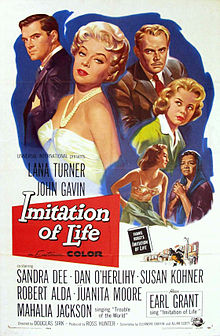Imitation of Life -The Movie
by mitzimsa on February 28, 2016
Imitation of Life – African-Americans
Box Office Profit
 African-Americans make up 40 percent of attendance of movie goers today we are increasing the bottom line at the box office. In most instances this holds weight but as of recent events we are left felling slighted for our contribution in the success of pushing a movie to big box office profits. Even back in 1959 African-American made up 30 percent of the audience of movies. Imitation of Life is the second film adaptation of Fannie Hurst’s novel inspired by Zora Neals Hurston of the same name first released in 1934. The 1959 version a romantic drama released by Universal International and was the final Hollywood film directed by Douglas Sirk which dealt with issues of race, class and gender. It took the remake of this movie released in 1959 for the studio to make an unprecedented decision to release movies simultaneously to both white and black theaters in the South for the first time ever.
African-Americans make up 40 percent of attendance of movie goers today we are increasing the bottom line at the box office. In most instances this holds weight but as of recent events we are left felling slighted for our contribution in the success of pushing a movie to big box office profits. Even back in 1959 African-American made up 30 percent of the audience of movies. Imitation of Life is the second film adaptation of Fannie Hurst’s novel inspired by Zora Neals Hurston of the same name first released in 1934. The 1959 version a romantic drama released by Universal International and was the final Hollywood film directed by Douglas Sirk which dealt with issues of race, class and gender. It took the remake of this movie released in 1959 for the studio to make an unprecedented decision to release movies simultaneously to both white and black theaters in the South for the first time ever.
1959 – Adaptation Imitation of Life
Imitation of Life is a story of a light-skinned black girl Sarah Jane born to Annie a single black mother that was befriended by Lora a single white women and Susie her daughter that recently moved to New York to follow her dream of an acting career. Lora invites Annie and Sara Jane to stay the night in her apartment in exchange Annie offer to keep house and look after Susie while Lora seeks acting and modeling jobs. Sarah Jane’s life was just fine until her mother Annie shows up to her school one day and discovers that her daughter has been trying to conceal her true race from her classmates. As the movie moves forward Sarah Jane secretly starts to date a white boy and decides that she would rather die than to be considered black. When her boyfriend learns that Sarah Jane’s mother is black he beats her. Sarah Jane leaves home claiming that she has found work in a library but, her mother finds her dancing and singing in a seedy nightclub. Once again her mother’s appearance embarrasses and reveals that she is black and cost her, her job. So Sarah Jane goes on the run once again. Annie decides that she will no longer interfere in her daughter’s life in fear that will run or be mistreated if her true color is uncovered. Later in the movie, Annie becomes ill and is convinced that she is dying, she obtains information that her daughter is working as a chorus girl in Los Angeles and flies to California for one last look at her daughter. Sarah Jane is furious with her mother’s decision to come to Los Angeles and exclaiming, “I’m somebody else, I’m white. Annie introduces herself to her white friend as Sarah Jane’s former nanny and leaves with an embrace and thank you from her daughter for not revealing Sarah Jane’s truth. Annie puts her affairs in order and ensures all her possessions are left to Sarah Jane and goes on home to glory. Lora gives Annie the elaborate funeral that she had requested. During the long cortege moves slowly along the street, Sarah Jane pushes through the crowd flings herself on her mother’s coffin, and weeps hysterically how sorry she is for the way she has treated her mother. Sarah Jane is lead to the hearse by Lora and Susie while reassure her that she did not cause her mother’s death through the lack of showing love and acknowledgement of her mother and race.
Imitation of Life Movie Is A Must See For Every Generation
I do believe that most Baby Boomers are familiar with this film but Generation X and the Millennials may have no idea the movie exists. Unlike in the 21st century where other races and cultures are embracing the African America Culture while referring to it as Urban Culture has the culture been embraced in a positive manner. African Americans of generations before were trying to pass for white if possible to afford more opportunity for advancement and acceptance in life. In 2015 the United States Library of Congress selected the Imitation of Life for preservation in the National Film Registry with the findings of it being culturally, historically and aesthetically significant in American history just like the original 1934 film.











Post Your Comment Here